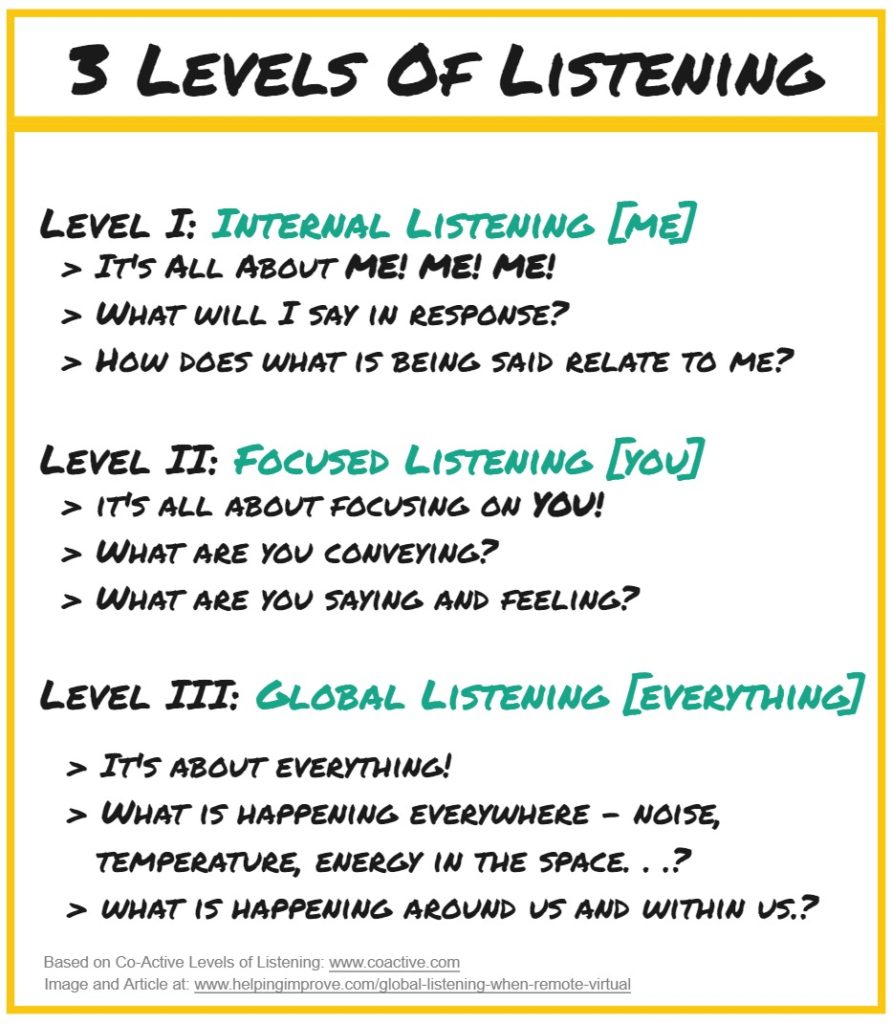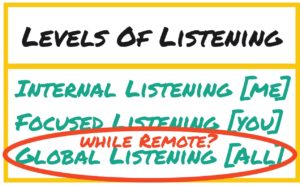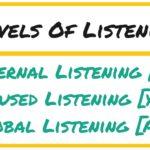Many people are working from home at this point and this will obviously continue for a while. Many organizations had already been working remote. I’ve worked on a number of remote teams and with a number of remote organizations well before the current situation we are in. I’ve done remote work as a coach, trainer, product manager, and team member well before the current situation we are in. Each of those instances I found myself enjoying some aspects of the work and also wishing for aspects to be in person. One of the most challenging things to do remotely is to listen.
Three Levels of Listening
The reality is, that many of us struggle to listen in-person, so the problems of listening are not suddenly new. One of the topics we cover in leadership training is around the levels of listening. Specifically the three levels of listening introduced by the Co-Active Training Institute and in their book, Co-Active Coaching.

There are many articles that get into more depth on each level. So grab the book or search the internet (there are a LOT of different articles on the levels of listening – and not just these levels, all kinds of variations).
Listening While Remote
I’ve had a few people ask me “How do I globally listen when I’m remote?” Typically, when we are in person things that we might listen for would be body language, spacing, temperature, environment sounds, the weight or sense in the room, or energy of the room. . . among others. When you are used to listening for those things in-person only, it can seem almost impossible to do globally listen these when you are remote. However, there are quite a few options:
- This article I recently read, Listening in the Virtual Space, has some tips that are helpful to consider. Listening for aspects like tone, pitch, and speed are important to consider. You are never looking to mimic them, but if someone is talking in a quiet, deliberate, slower-paced cadence – having you respond with loud rapid-fire comments is a good example of not globally listening.
- Know where to look in your camera so that you are looking DIRECTLY at the person. Looking directly at the lens of your camera does NOT always mean that people see you looking directly at them. Test your camera setup with someone and mark your camera. If you have a standing desk and change positions, you might need to mark two locations. In order to look directing at someone, one of my cameras is off by 2″ from the lens (given the angle?). All that said, don’t just stare at that spot, use it from time to time as you would in a face to face conversation.
- Consider what it means to align yourself with the feeling, the space, and/or the sentiment of what you are hearing. If someone is speaking softly, are you very loud? While you don’t want to mimic people, are you on the same page that they are or at least the same chapter?
- Adjust your chair and your posture. Consider rolling your chair back 6-18″ (or stepping back if you are standing). If that makes you feel too far away, move closer. But instead of having your hands on the keyboard, put them on your lap. Focus on listening to the words, intent, and everything that you can “hear” beyond words – all the items above) and decouple from your keyboard. Lay your phone down where you can’t see the alerts (unless you are on the phone of course!). There is also an opportunity to sometimes see more of a person than just their/your face – so you might see their hands moving for example. They might see yours. Others may not be comfortable moving backwards, so unless you know them quite well, focus on doing this yourself (vs. asking them to do it). Practice doing this a few times a day. If you are in a longer video session, just try it for 2-3 minutes a few times per call. What do you like? What do you not like? What do you notice? Inspect & adapt and all that fancy stuff!

- Don’t let the video cause you to forget what you likely already know. Try having some discussions WITHOUT video. Try having a few conversations a week via phone or with video off. I was teaching a class today. For one of the exercises, everyone was going to be working independently on an exercise that involved some personal in-depth thinking. I asked them to turn video off, and when they were done, to turn it back on. Sometime people need a break from the video anyway (and no, having video on does NOT mean people are engaged). As you try some calls with no video or via phone, ask yourself the same questions as the prior suggestion. What do you notice? What did you learn? What did you hear that you did not before?
Questions, comments, ideas, concerns? Fire away – let me know in the comments!









I work as a communication coach and I think that listening is one of the most important parts of communicating. Global listening is key if you want to be a great public speaker, as reading the audience and feeling the energy flowing around is crucial. Thanks for the post!